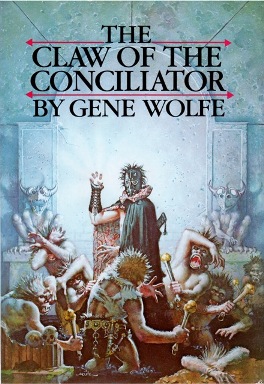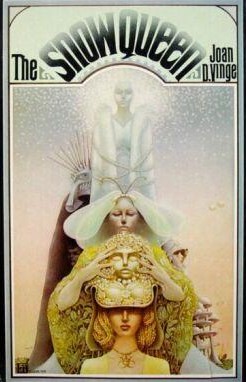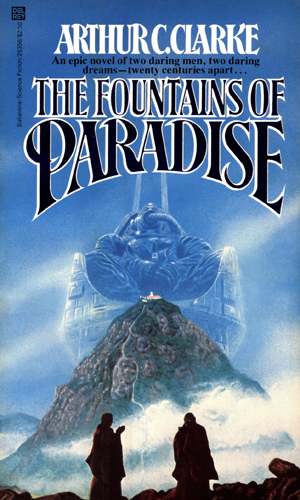
Ah, now
this is more like it. David Brin’s 1984 Hugo Winner Startide Rising is a much better than the previous year’s winner, Isaac
Asimov’s Foundation’s Edge. The
universe is more interesting, the characters are more developed, and there is a
real feeling of danger and discovery that was absent from the last Hugo winner.
And if you are wondering, yes, the cover is not lying: there are space dolphins
in this book. Startide Rising is a
story about aliens, a strange world, and a ship full of dolphins, a few humans,
and a very wet chimpanzee.
Startide Rising takes place in a galaxy
full of alien life. Every intelligent species had been “uplifted” by a previous
species all the way back to a mythic first species. However, humanity has no
patron that uplifted it and humans claim to have evolved naturally. Such a
claim is borderline blasphemous among many members of the intergalactic
community and leaves humanity a pariah. Humanity does receive some respect for
having uplifted two other species: chimpanzees and dolphins. It is an
interesting premise for science fiction and I enjoyed writing about the racial
and societal dynamics at play. Humans treat their uplifted clients differently
the most alien races. Most uplifted races are held in servitude for 100,000
years while humans treat chimps and dolphins as relative equals. I also
appreciated that Brin’s various aliens are not necessarily humanoid. Many of
the aliens described in the book are strange (very much outside of the Star Trek-esque humanoid norm) and the
little bits of their culture provide a fun taste without going into too much
detail.
The
story begins a month after the Terran ship Streaker
fled a number of competing alien fleets after finding a derelict fleet of
50,000 spaceships the size of small moons. These ships are millions of years
old and may hold secrets to the progenitor race that started the whole uplift
practice. As the novel begins, Streaker
is hiding on the small water world of Kitrup to make repairs while the opposing
alien fleets fight each other in the sky above. Only the antagonism between all
the other fleets give the terrans the time they need to reorganize but also
leaves them trapped. The set up gives the story a vital element that Foundation’s Edge completely lacked:
tension. The crew has to deal with the constant threat of discovery by hostile alien
powers while at the same time struggling with the unknown environment and an
eventual mutiny. These competing elements can occasionally get lost in the
shuffle but the author mostly manages to balance them.
Brin constantly shifts perspective
to the various crew members and occasionally to the aliens battling out in the
skies above. I rarely lost track of what was going despite all the shifts.
Sometimes, I would get a few of the dolphins mixed up because their names sound
so similar. That said, I liked how Brin decided to go with primarily dolphin
crew (convenient also since Kithrup is a water world) rather than a primarily
humans crew with a few token aliens. It was a nice change of pace from human
dominated fiction. It changes the nature of a lot of the interactions and even
how the ship is designed. Since its crewed by dolphins, the ship is full of
hyper-oxygenated water rather than air so its design and operation is
significantly different. The dolphins are not fully evolved so how they deal
with the stress of their situation and react to one another is a highpoint of
the story. The low point had to be the dolphin sex scene, an element that
neither I nor the book needed. A water logged ship also makes for a very unhappy
chimp. The chimp, Dr. Charles Dart, is one of my favorite characters. He is the
ship’s planetologist and is so dedicated to the study of the new planet that he
seems annoyed rather than frightened of dangerous situation.
The science in the book has aged
well; very little struck me as strangely anarchistic though there are elements
that are still somewhat a product of its time. There is definitely the 1980s
fascination with Japan buried subtlety into the book. The dolphin names are
similar to Japanese names and the dolphins themselves speak to each other in
Trinary which has a haiku-like structure. None of this is done in a
stereotypical or insulting way (see George Lucas and the Trade Federation in
the Star Wars prequels) but I found it worth noting.
Good fiction in general, and
science fiction in particular, should draw the reader into a new world and
leave the reader eager to learn more. Startide
Rising is good fiction that does not move into the realm of great fiction. It
was a lot of fun learning about the Uplift Universe and the adventures of the Streaker’s crew were very enjoyable. Startide Rising is a welcomed
improvement of Foundation’s Edge. It is
not a classic but certainly a worthy addition to the Hugo Winners and a fine
example on how to make an excellent space opera adventure. I am excited for
Brin’s next Hugo winner, 1988’s The
Uplift War. Next up is Neuromancer,
the William Gibson novel that serves as the foundation of the cyberpunk
subgenre. Get ready to move from space adventure to computer hacking in a
future dystopia. See you then.





